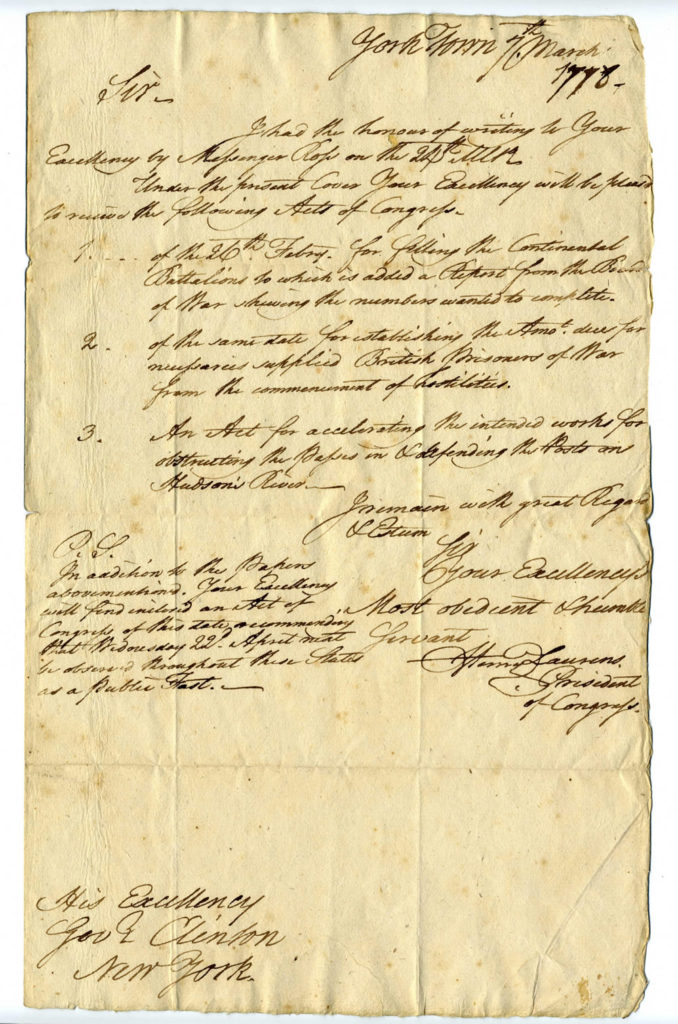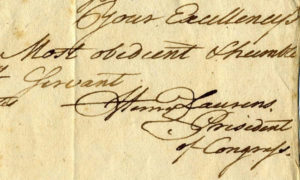Collection Gem : April 2018

Collection Gem articles were broadened to include manuscripts in the Society’s holdings. This month features a letter stored in Collection 18, HCHS Collection Part I, Box 3, Folder 103. It’s a letter to New York’s Governor George Clinton from Henry Laurens, President of the Continental Congress (Figure 1) which was accompanied by the text of four approved Acts of Congress. Several noteworthy items are apparent.

Laurens was writing from “York Town”, conjuring thoughts of Virginia. But this byline consists of two words (Figure 2) and is dated 7th March 1778. This was a month after France recognized American independence, but the British army still occupied the fledgling United States’ capital of Philadelphia. During this occupation the Continental Congress met in York, Pennsylvania from 30 September 1777 until 27 June 1778, thus the timing of the letter corresponds to this period.
The communication from President Laurens to Governor Clinton includes news of three acts passed Congress and mentions a fourth in a postscript.
1 — passed on 26 February 1778, this Act specifies state-specific quotas to fill Continental Battalions (the Act’s text begins on page 200 at this link):
https://memory.loc.gov/cgi-
2 — this Act – passed the same day as the above mentioned – approved reimbursement of states for their expenses incurred providing for the subsistence of British POWs since the commencement of hostilities (page 198 here for the Act’s text):
https://memory.loc.gov/cgi-
I first thought this wouldn’t mean much to New York state, but then realized this was dated after Saratoga and may have amounted to a very substantial sum since what eventually became known as the “Convention Army” exceeded 6,000 men!
3 — this refers to an Act passed 5 November 1777 approving a number of measures intended to provide for the defenses along “Hudson’s River” (begins on page 865 of this link):
https://memory.loc.gov/cgi-
[An aside: a recent article about the River’s defenses can be found here:
https://allthingsliberty.com/
The postscript mentions the Congress proclaimed 22 April 1778 a Day of Fasting in an Act passed on the date of the letter, 7 March 1778 (page 229 on the link):
https://memory.loc.gov/cgi-
The full 23 page text of a sermon given that day by Rev. Jacob Green in Hanover, NJ can be found here (thank you to Robert Leith!):
https://quod.lib.umich.edu/e/
More information on Reverend Jacob Green is on the New Jersey Historical Society website where his manuscripts collections are preserved:
http://www.jerseyhistory.org/

Another interesting question arises when reading the letter. An earlier(?) communication was sent “by Messenger Ross” (Figure 3). Was this George Ross, a Pennsylvania representative to the Continental Congress? His nephew was married to Betsy Ross, who needs no introduction. George was a signer of the Declaration of Independence and in 1776 was a colonel in the Continental Army. He also served several terms in the Continental Congress. He resigned from Congress due to poor health in 1777. The following year he was appointed a judge of the court of Admiralty in Pennsylvania, an office he still held when he died of gout in July 1779. While I cannot prove “Messenger Ross” as George, clearly the communication was important enough to be handed to a trusted individual.
As for Governor George Clinton, he was Governor of New York for 21 years, the longest tenure in State history. He also served as the fourth Vice-President or the new nation, and was the first elected VP (previous VPs being appointed), serving under Thomas Jefferson and James Madison.

The letter was seen by, and mentions, some amazingly important individuals in American history, signed by the once President of Congress, Henry Laurens. (Figure 4) Truly a Gem!
